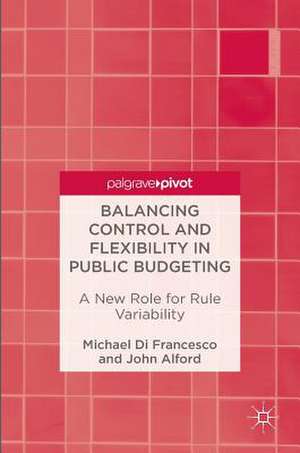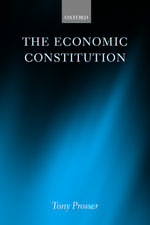Balancing Control and Flexibility in Public Budgeting: A New Role for Rule Variability
Autor Michael Di Francesco, John Alforden Limba Engleză Hardback – 24 mai 2016
This work explores how reshaping budget rules and how they are applied presents a preferred means of public sector budgeting, rather than simply implementing fewer rules. Through enhanced approaches to resource flexibility, government entities can ensure that public money is used appropriately while achieving the desired results.
The authors identify public budgeting practices that inhibit responses to complex problems and examine how rule modification can lead to expanded budget flexibility. Through a nuanced understanding of the factors underlying conventional budget control, the authors use budget reforms in Australia to show the limits of rule modification and propose "rule variability" as a better means of recalibrating central control and situational flexibility.
iv>
| Toate formatele și edițiile | Preț | Express |
|---|---|---|
| Paperback (1) | 376.96 lei 43-57 zile | |
| Springer Nature Singapore – 27 mai 2018 | 376.96 lei 43-57 zile | |
| Hardback (1) | 382.95 lei 43-57 zile | |
| Springer Nature Singapore – 24 mai 2016 | 382.95 lei 43-57 zile |
Preț: 382.95 lei
Nou
Puncte Express: 574
Preț estimativ în valută:
73.28€ • 76.71$ • 60.63£
73.28€ • 76.71$ • 60.63£
Carte tipărită la comandă
Livrare economică 07-21 aprilie
Preluare comenzi: 021 569.72.76
Specificații
ISBN-13: 9789811003400
ISBN-10: 9811003408
Pagini: 102
Ilustrații: XV, 101 p. 1 illus.
Dimensiuni: 148 x 210 x 8 mm
Greutate: 0.3 kg
Ediția:1st ed. 2016
Editura: Springer Nature Singapore
Colecția Palgrave Macmillan
Locul publicării:Singapore, Singapore
ISBN-10: 9811003408
Pagini: 102
Ilustrații: XV, 101 p. 1 illus.
Dimensiuni: 148 x 210 x 8 mm
Greutate: 0.3 kg
Ediția:1st ed. 2016
Editura: Springer Nature Singapore
Colecția Palgrave Macmillan
Locul publicării:Singapore, Singapore
Public țintă
ResearchCuprins
1. Introduction.- 2. Non-routine problems and flexibility.- 3. Flexibility, inflexibility and budgeting.- 4. Budget rules and budget flexibility.- 5. Budget reform and rule modification.- 6. Calibrating budget flexibility and control: A new role for rule variability.- 7. Conclusion.
Notă biografică
Michael Di Francesco is an Associate Professor and Case Program Director at the Australia and New Zealand School of Government, and the School of Social Sciences, University of New South Wales (UNSW), Australia. He has held academic appointments at the Universities of Sydney and Melbourne, and Victoria University of Wellington, and expert advisory roles at the NSW Treasury, International Monetary Fund and World Bank.
John Alford is Professor at the Australia and New Zealand School of Government and the Melbourne Business School, University of Melbourne, Australia. He is an international authority in the areas of public value and client-organization relationships. His most recent Palgrave publication is (with Janine O’Flynn) Rethinking Public Service Delivery (2012), winner of the 2013 Academy of Management (Public/Non-Profit Division) Best Book Award.
Textul de pe ultima copertă
Michael Di Francesco is an Associate Professor and Case Program Director at the Australia and New Zealand School of Government, and the School of Social Sciences, University of New South Wales (UNSW), Australia. He has held academic appointments at the Universities of Sydney and Melbourne, and Victoria University of Wellington, and expert advisory roles at the NSW Treasury, International Monetary Fund and World Bank.
Caracteristici
Focuses on a "blind spot" in budgeting literature, analyzing how the rigidity of budget processes in the public sector inhibit the collaboration and agility needed in responding to complex non-routine problems Illuminates contending understandings of the nature of budget control and offers practical recommendations to policy makers on how to reconfigure centralized budget control for greater flexibility Offers a number of genuinely novel contributions to analyzing public management structures and practices, such as a taxonomy of budget control properties that unpacks the mechanisms inhibiting flexibility as well as an application of responsive regulatory approaches to budget control















